Implement Teamwork and Communication for Perinatal Safety: Facilitator Guide
AHRQ Safety Program for Perinatal Care
Slide 1: Implement Teamwork and Communication for Perinatal Safety

Say:
The Implement Teamwork and Communication module of the AHRQ Safety Program for Perinatal Care will help you understand the importance of effective communication and transparency, identify barriers to communication, and apply the effective teamwork and communication tools from the Comprehensive Unit-based Safety Program, or CUSP, and TeamSTEPPS®.
Slide 2: Learning Objectives

Say:
In this module, we will—
- Recognize the importance of effective communication.
- Identify barriers to communication.
- Describe the connection between communication and medical errors.
- Identify and apply effective communication strategies from CUSP and TeamSTEPPS®.
Slide 3: Basic Components and Process of Communication

Say:
Communication, both verbal and nonverbal, is complex and subject to distortion or misinterpretation as it is encoded and decoded between communicators. In verbal communication, ideas are first encoded, or created, when the sender speaks to the receiver. The receiver then decodes, or interprets, the message. The interpretation is affected by the context, auditory distractions, and the individual makeup of the participants involved in the conversation.
These seemingly insignificant elements comprise the overall communication system in which providers share information, ideas, and needs within the health care setting. Each aspect is interconnected and dependent on the influences and composition of the others, meaning a distraction or malfunction in the encoding process or any other component in the model impairs decoding and understanding.
The background and physical environment of the communicators influences the distribution and receipt of messages. Individuals are unique, and their experiences dictate how messages are created, shared, and understood. Knowing this, individuals in health care settings can affect the outcome of their interaction with colleagues by realizing how to effectively share ideas and comprehend those of others.
Slide 4: Four Key Components of Effective Communication

Say:
Effective communication is complete.
- It communicates all relevant information while avoiding unnecessary details that may cause confusion.
- It allows time for patient and staff questions and answers questions completely.
Effective communication is clear.
- It uses plain language, such as layman's terms, that patients and their families can easily understand.
- It uses common or standard terminology when communicating with team members.
Effective communication is brief and concise.
Effective communication is timely.
- It offers and requests information.
- It avoids compromising a patient's situation by promptly relaying information.
- It notes times of observations and interventions in the patient's record.
- It updates patients and families frequently.
- It verifies the recipient received the intended message.
- It validates or acknowledges information received.
An example of effective communication is applying the four elements to a recommendation to proceed with a cesarean section for a laboring patient:
- Complete—it includes the medical reason for recommending a cesarean section and risks associated with not proceeding to a section.
- Clear—It is conveyed using plain language and avoiding medical jargon.
- Brief—It contains only the necessary information.
- Timely—It is communicated to the patient as soon as possible after the decision has been made by the attending physician.
Slide 5: Elements That Affect Communication and Information Exchange

Say:
Several elements can affect communication and information exchange:
- Interruptions limit the ability of team members to discuss and comprehend necessary information.
- Staff discussing certain tasks to the exclusion of all others reduces the focus of labor and delivery or L&D unit team efforts.
- Verbal abuse creates a hostile environment in which team members do not feel comfortable sharing ideas or collaborating to solve an issue.
- Fatigue decreases the level of attention and energy that team members are able to devote to the project.
- Ambiguous orders or instructions cloud expectations and plans.
- Change in team members strains existing work relationships between L&D unit team members and the newest additions to the unit team.
- Heavy workloads hinder clear communication.
Slide 6: Root Causes of Maternal and Perinatal Deaths and Injuries 2004-2012

Say:
Human factors and communication breakdowns are identified as the primary root cause of maternal and perinatal deaths and injuries. According to the Joint Commission, these errors are reported over 50 percent of the time and represent the majority of repairable defects within the L&D unit.
Other root causes for maternal and perinatal deaths and injuries are—
- Assessment.
- Leadership.
- Information management.
- Physical environment.
- Continuum of care.
- Care planning.
- Medication use.
Slide 7: Barriers to Team Effectiveness

Say:
There are many barriers to effective team performance.
Working condition barriers include—
- Lack of coordination or followup.
- Distractions.
- Misinterpretation of cues.
- Hierarchy.
- Lack of clarity on rules and responsibilities.
- Physical proximity.
- Shift changes.
Resource barriers include—
- Lack of time.
- Workload.
- Processes.
- Technology.
Team composition barriers include—
- Inconsistency in team membership.
- Lack of role clarity.
- Defensiveness.
- Conventional thinking.
- Conflict.
- Fatigue.
- Complacency.
- Varying communication styles.
- Personality.
Slide 8: Positive Outcomes of Effective Teamwork on Health Care

Say:
Effective teamwork has a positive effect on health care, and is associated with—
- Reduced length of stay.
- Higher rates of quality care.
- Better patient outcomes.
- A greater ability to meet family member needs.
- Improved patient experience with cares cores.
- Lower rates of nurse turnover.
By taking the time to engage in effective communication, team members can contribute to the safety of their L&D unit for their colleagues and patients.
Slide 9: Shadowing

Say:
Using the Shadowing Another Professional tool is a way to examine and understand the cultural differences that exist between various professions. The individuals who shadow and who are shadowed may rotate based on specific L&D unit challenges. Executives, obstetricians, nurse managers, pediatric providers, pharmacists, anesthesiology providers, midwives, nurses, and L&D unit support staff approach issues in distinct ways, and shadowing provides everyone an opportunity to experience these differences.
Shadowing allows individuals to experience the work culture of their colleagues and gain a deeper appreciation for the demands and challenges of each role. Shadowing often helps expand an individual's interest and willingness to participate in improvement projects. Team members who shadow gain perspective of other roles, environments, and areas that are different from their own.
These areas include practice, responsibilities, and work environment.
Teams can integrate shadowing into their daily activities by using administrative or personal development time. Shadowing aids in the professional development of L&D unit team members by providing them the background needed to identify issues that affect teamwork and communication. These problems can impair the quality of care and outcomes for a patient.
Slide 10: Selected TeamSTEPPS Tools

Say:
L&D units can use the TeamSTEPPS tools listed on this slide to improve communication and teamwork. We will briefly describe most of these tools here; however, full training on how to use these tools is provided through TeamSTEPPS training. Information about TeamSTEPPS training is available at the AHRQ Web site, https://www.ahrq.gov/teamstepps/index.html.
Slide 11: Briefing

Say:
Briefings are held among team members for planning purposes.
A briefing immediately does the following:
- Maps out the care plan for one or more patients.
- Identifies each team member's roles and responsibilities for the safety of the patient.
- Heightens the team's awareness of a situation.
- Permits the team to plan for the unexpected.
- Allows team members' needs and expectations to be met so they can work effectively.
- Sets the tone for the day.
- Encourages team members' participation in an activity or task that is scheduled to take place.
Briefings are conducted:
- At the beginning of the day shift.
- Before any procedure in any setting.
- When a change in patient status results in deviation from the plan of care.
- During reporting-off breaks and shift changes.
The tools for situational and excess shift adjustments call for slightly different reporting tools, but briefings remain the standard format for delivering information that is clear and correct.
Slide 12: Huddle
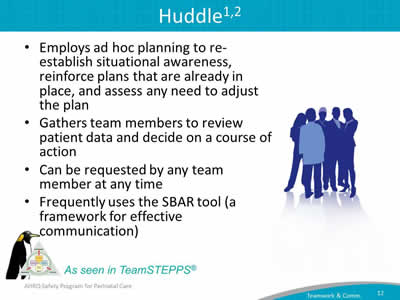
Say:
The huddle serves as a method for generating a shared understanding among team members regarding the plan of care when situational changes mandate the reassessment of plans and goals. Huddles also present team leaders with an opportunity to informally monitor patient- and unit-level situations by gathering the team to discuss a situation and collectively develop a plan.
Updates can take the form of a huddle at the status board or can occur among individual team members whenever new information needs to be shared.
Here is an example of a huddle:
On a very busy evening shift, the intensive care unit Green Team has four patients. During a huddle, the team leader decides that Patient A can be transferred to the step-down unit if his arterial blood gasses after extubation are acceptable. The team is also alerted about an elderly patient with severe pneumonia who is being admitted from the emergency department.
Slide 13: Debriefing
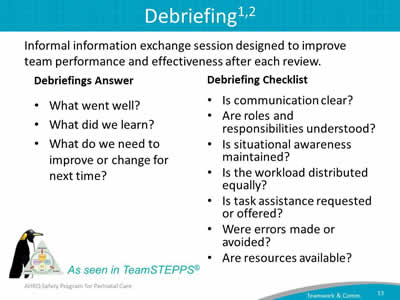
Say:
Debriefings are information exchange sessions that are designed to improve team performance and effectiveness with each use.
Debriefings answer these questions:
- What went well?
- What did we learn?
- What do we need to improve or change for next time?
Therefore, debriefings include—
- An accurate recounting and documenting of key events.
- An analysis of why an event occurred, what worked, and what did not work.
- A discussion of lessons learned and how staff will alter the plan next time.
- The establishment of a method to formally change the existing plan to incorporate lessons learned.
Debriefings are most effective when conducted in an environment in which genuine mistakes are viewed as learning opportunities. The team leader typically initiates and facilitates debriefings, which are most useful when they relate to specific team goals or address particular issues related to recent team actions.
When conducting a debriefing, address the following questions:
- Is communication clear?
- Are roles and responsibilities understood?
- Is situational awareness maintained?
- Is the workload distributed equally?
- Is task assistance requested or offered?
- Were errors made or avoided?
- Are resources available?
Slide 14: STEP
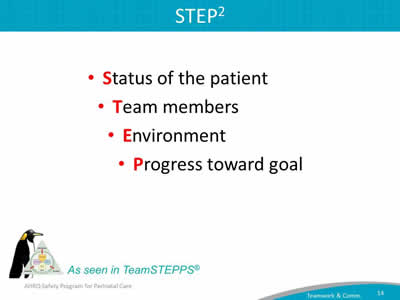
Say:
STEP is a tool for monitoring situations in the delivery of health care. The components of situation monitoring to be aware of and assess the following:
- Status of the patient, including history,vital signs, medications, physical exam,plan of care, and psychosocial status.
- Level of team members' fatigue, workload, task performance, skill, and stress levels.
- Environment, including information about the facility and its administration, human resources, triage acuity, and equipment.
- Progress toward established team goals and toward knowing the status of the team's patients, and the team's tasks and actions, as well as performing an assessment of whether plans to reach the goals are still appropriate.
Slide 15: I'm Safe
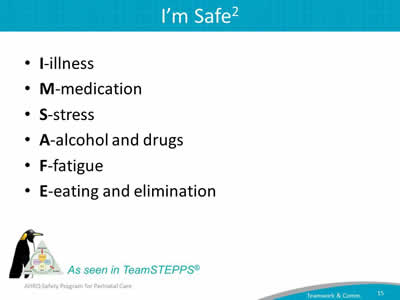
Say:
I'M SAFE is a simple checklist that helps you determine your and your coworkers' ability to perform safely.
I stands for illness. Ask: "Am I feeling well enough to perform my duties?"
M stands for medication. Ask: "Am I taking a medication that could affect my ability to maintain situation awareness and perform my duties?"
S stands for stress. Ask: "Is there anything that is detracting from my ability to focus and perform my duties?"
A stands for alcohol and drugs. Ask: "Is my use of alcohol or illicit drugs affecting me so that I cannot focus on the performance of my duties?"
F stands for fatigue. Ask: "Am I rested enough to perform my duties?"
And E stands for eating and elimination. Ask: "Has it been 6 hours since I have eaten or used the restroom?" Not taking care of our dietary and elimination needs affects our ability to concentrate and stresses us physiologically.
Slide 16: Task Assistance
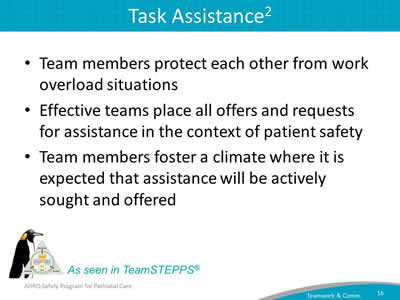
Say:
Task assistance is a form of mutual support among team members that also supports patient safety. By preventing work overload and by promoting, acknowledging, and acting on offers and requests for assistance, team members protect both themselves and their patients from stress and harm.
Slide 17: Feedback
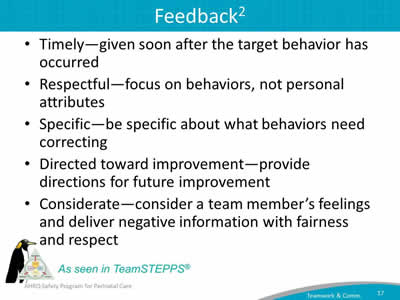
Say:
Feedback, as a form of mutual support, is information provided for the purpose of improving team performance. To be effective and to promote a supportive climate, feedback must be—
- Timely.
- Respectful.
- Specific to the behavior.
- Directed toward improvement.
- Considerate.
Slide 18: Advocacy and Assertion
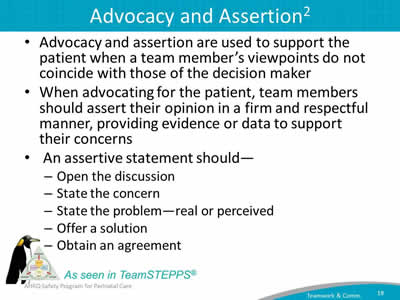
Say:
Team members invoke advocacy and assertion interventions when their viewpoints do not coincide with that of a decision maker. In advocating for the patient and asserting a corrective action, the team member has an opportunity to correct errors or the loss of situational awareness. Failure to employ advocacy and assertion frequently has been identified as a major contributor to the clinical errors found in malpractice cases and sentinel events.
You should advocate for the patient even when your viewpoint is unpopular, is in opposition to another person's view, or questions authority. When advocating, asserting your viewpoint in a firm and respectful manner is imperative. You should also be persistent and persuasive, providing evidence or data to support your concerns.
Slide 19: Two-Challenge Rule
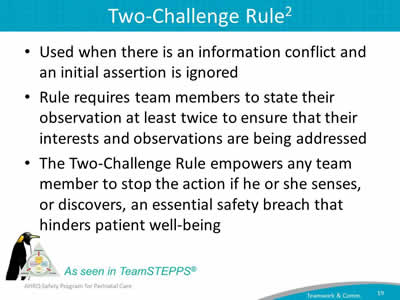
Say:
You should voice your concerns using advocating and asserting statements at least twice if your initial assertion is ignored, thus the name "Two-Challenge Rule." These two attempts may come from the same person or two team members. The first challenge should be in the form of a question. The second challenge should provide some support for your concern for the patient. The two-challenge tactic ensures an expressed concern has been heard, understood, and acknowledged.
There may be times when an initial assertion is ignored. After two attempts, if the concern is still disregarded but you believe patient or staff safety is or may be severely compromised, the Two-Challenge Rule mandates taking a stronger course of action or enlisting the help of a supervisor. This overcomes our natural tendency to believe the medical team leader must always know what he or she is doing, even when the actions depart from established guidelines. When invoking this rule and moving up the hierarchy, you need to communicate to the entire clinical team that you have solicited additional input.
If you are challenged by a team member, you must acknowledge the concerns and not ignore the person. All team members should be empowered to "stop the line" if they sense or discover a fundamental safety breach. This is an action that should never be taken lightly but requires the process to immediately cease to resolve the safety issue.
Slide 20: DESC Script
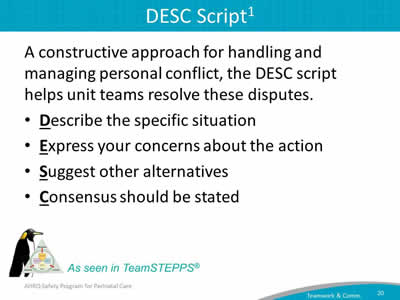
Say:
The DESC script can be used to communicate efficiently during all types of conflict and is most effective in resolving personal conflict. The DESC script is used in high-conflict scenarios in which behaviors are not practiced, hostile or harassing behaviors are ongoing, and safe patient care is suffering.
DESC is a mnemonic device:
- D stands for describe—Describe the specific situation.
- E stands for express—Express your concerns about the action.
- S stands for suggest—Suggest other alternatives and seek agreement.
- And C stands for consequences—Consequences, in terms of established team goals, should be stated.
Ultimately, by using the DESC script, an agreeable solution should be developed by the team members.
There are some crucial things to consider when using the DESC script:
- Time the discussion.
- Despite your interpersonal conflict,team unity and care quality depend oncoming to a resolution that all parties find acceptable.
- Frame problems in terms of personal experience and lessons learned.
- A private location away from the patient or other team members will allow both parties to focus on resolving the conflict rather than on saving face.
- "I" statements, instead of blaming statements, are more effective (i.e., "If you are concerned or have a question regarding my performance, I would appreciate it if you would speak to me in private.").
- Accept that a critique is not a personal criticism.
- The conversation should focus on what is right, not who is right.
Slide 21: CUS
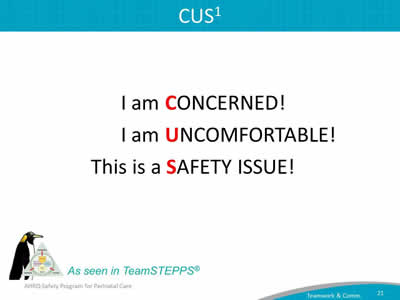
Say:
CUS is an acknowledgment of an unsafe situation. When you use CUS, you state your concern, you state why you are uncomfortable, and then you state that this is a safety issue.
Slide 22: Collaboration
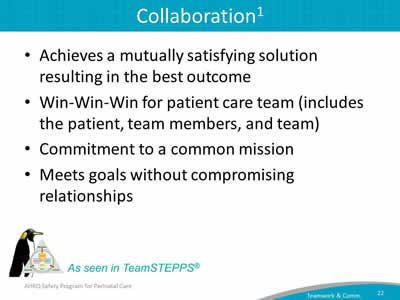
Say:
Collaboration is defined as the act of working together with one or more people to achieve a goal. When unit teams collaborate, they have a commitment to a common mission, which they are more likely to reach as a group rather than as isolated individuals.
Slide 23: SBAR
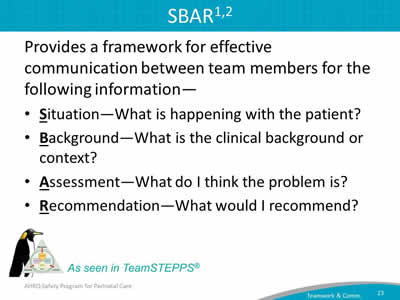
Say:
The SBAR technique provides a standardized framework for members of the team to communicate about a patient's condition.
SBAR is an easy-to-remember, concrete mechanism that is useful for framing any conversation, especially a critical discussion requiring a clinician's immediate attention and action. In phrasing a conversation with another member of the team, consider the following:
- Situation—What is happening with the patient?
- Background—What is the clinical background?
- Assessment—What do I think the problem is?
- Recommendation—What action would I recommend?
You may also refer to this as the ISBAR where the I stands for "introductions."
Introduction—What is your name and role on the team?
Slide 24: Callout
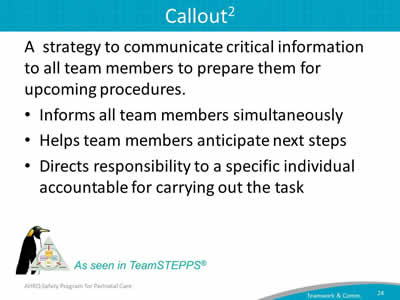
Say:
A callout is a tactic used to convey critical information during an emergency. Critical information called out in these situations helps the team anticipate and prepare for vital next steps in patient care. One important aspect of a callout is directing the information to a specific individual.
Example:
The nurse says to the doctor, "Doctor, the patient's blood pressure is dropping; it is 60/40."
The doctor replies, "Run fluids wide open and start the dopamine drip, please."
Ask:
On your unit, what information would you want called out?
Slide 25: Check-Back
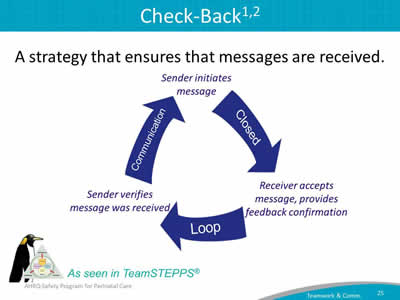
Say:
A check-back is a closed-loop communication strategy to verify and validate information exchanged between two people. The strategy entails the sender initiating a message, the receiver accepting the message and confirming what was communicated, and the sender verifying the correct message was received.
The message sender calls out information about the patient (for example, by saying, "BP is falling, 80/40 down from 90/60."). The receiver acknowledges receipt of this message by confirming the information (for example, by saying, "Yes, the BP is falling"). The sender can now verify the correct message was received (for example by saying, "That's correct"). The sender and receiver both know information was communicated correctly.
Slide 26: Handoff
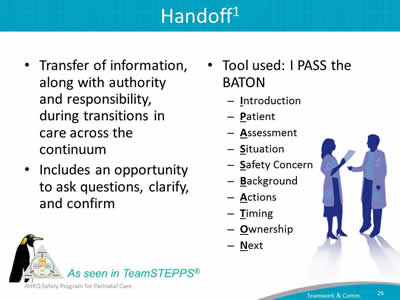
Say:
When a team member is temporarily or permanently relieved of duty, there is a risk that necessary information about the patient might not be shared with the replacement provider. The handoff strategy is designed to enhance information exchange at critical times, such as during transitions in care. Handoffs maintain the continuity of care despite changing staff and patients.
Handoffs include transferring knowledge and information about the degree of uncertainty (or certainty) about diagnoses, response to treatment, recent changes in condition and circumstances, and the care plan (including contingencies). In addition to patient care guidelines, both authority and responsibility are transferred from one team member to the next, making the handoff a crucial component of ensuring high-quality patient care.
A proper handoff includes the following components:
- Responsibility—When handing off, it is your responsibility to know that the person who must accept responsibility is aware of assuming responsibility.
- Accountability—You are accountable for patient care until both parties area ware of the transfer of responsibility.
- Uncertainty—When uncertainty exists,you are responsible for clearing up all ambiguity of responsibility before the transfer is completed.
- Verbal communication—You cannot assume that the person obtaining responsibility will read or understand written or nonverbal communications.
- Acknowledgment—Until it is acknowledged that the handoff is understood and accepted, you cannot relinquish your responsibility.
- Opportunity—Handoffs are a good time to review and have a new pair of eyes evaluate the situation for both safety and quality.
Ask:
When do you typically use handoffs in your unit?
Slide 27: Situational Awareness
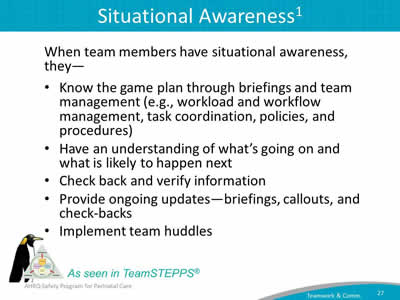
Say:
Situational awareness occurs when members of the team have a grasp of what is happening and what will likely happen next. Having this shared information will ensure the group takes the appropriate next steps together.
Using situational awareness, unit teams become more alert to developing situations, more sensitive to cues, and more aware of their implications with a focus on—
- Preparation, and planning and vigilance.
- Workload distribution.
- Distraction avoidance.
Focusing on these areas help improve team equality and support because team members share the responsibility of providing high-quality patient care with their colleagues and become further engaged in helping the team reach its safety goals.
Slide 28: Implement Teamwork and Communication: What the Team Needs To Do
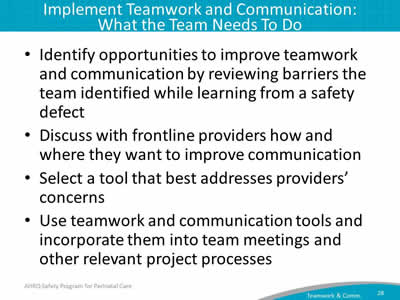
Say:
To further develop and support teamwork and communication, your team will need to—
- Identify opportunities to enhance these by reviewing barriers the team noted while learning from a safety defect.
- Discuss with frontline providers how and where they want to improve communication.
- Select a tool that best addresses providers' concerns.
- Use teamwork and communication tools and incorporate them into team meetings and offer other relevant project processes.
Slide 29: Additional CUSP Tools
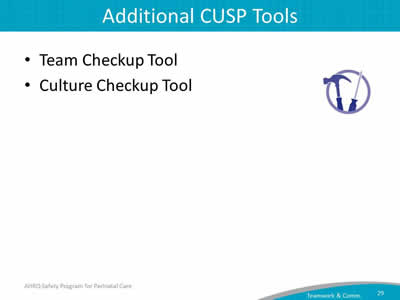
Say:
In addition to the information presented in this module, CUSP tools are available through the user support network of the Safety Program for Perinatal Care.
One tool that will help the L&D unit team understand teamwork and communication is the Team Check-Up Tool.
Team Checkup Tool
The Team Checkup Tool provides a standardized method for engaging in discussions about culture within the hospital. L&D unit teams first assess culture before starting an intervention, then use feedback from frontline providers to identify potential barriers to overcome, as well as strengths that can be better used. This tool can be used to target a goal for improvement shortly after the culture assessment and then every 3 to 6 months, or as needed, to initiate culture conversations, evaluate cultural issues (between survey administrations), and monitor the progress of culture change.
Culture Checkup Tool
The Culture Checkup Tool will help the unit team address problems identified in the unit patient safety culture assessment. This tool aids in the understanding of unit culture and will help the CUSP team carry out interventions to improve the local culture. With the tool, unit teams review the patient safety culture results to identify potential barriers and strengths team members can use as a basis for making culture and patient safety improvement decisions. Focusing the culture conversation on group-level data depersonalizes the discussion and fosters improvement in the context of the local realities of care delivery. The team can use the tool to target a goal for improvement shortly after the culture assessment and every 3 to 6 months, or as needed, to encourage culture conversations, evaluate cultural issues between survey administrations, and monitor the progress of culture change.
Slide 30: Summary
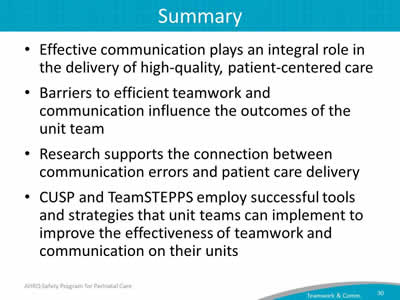
Say:
In summary—
- Effective communication plays an integral role in the delivery of high-quality, patient-centered care.
- Barriers to efficient teamwork and communication influence the outcomes of the L&D unit team and patient care.
- Research supports the connection between communication errors and errors in patient care delivery.
- CUSP and TeamSTEPPS have tools and strategies that L&D unit teams can employ to improve the effectiveness of teamwork and communication on their units.
Slide 31: References
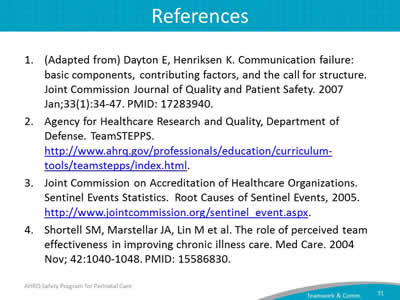
Slide 32: Disclaimers




